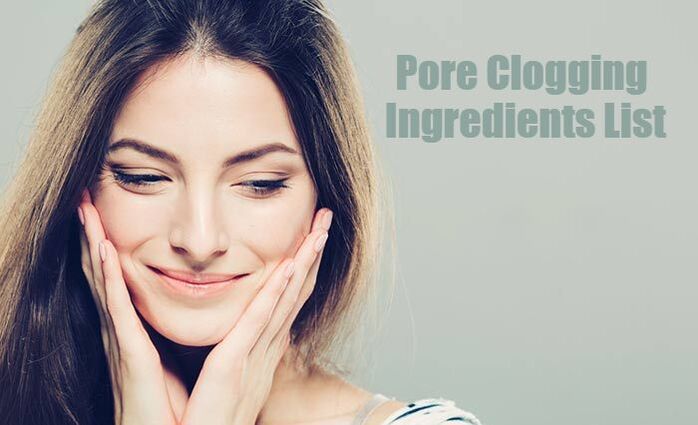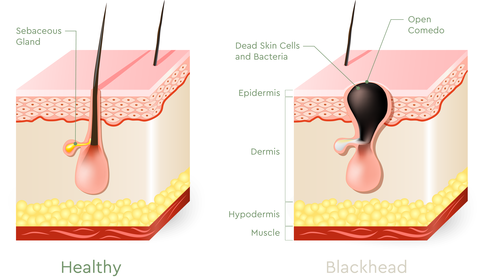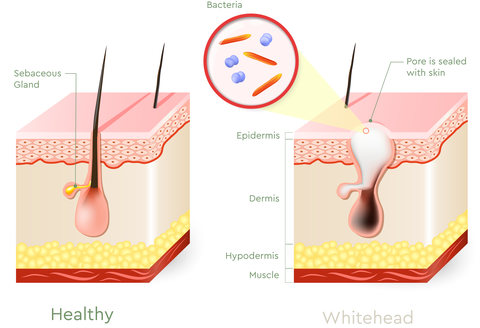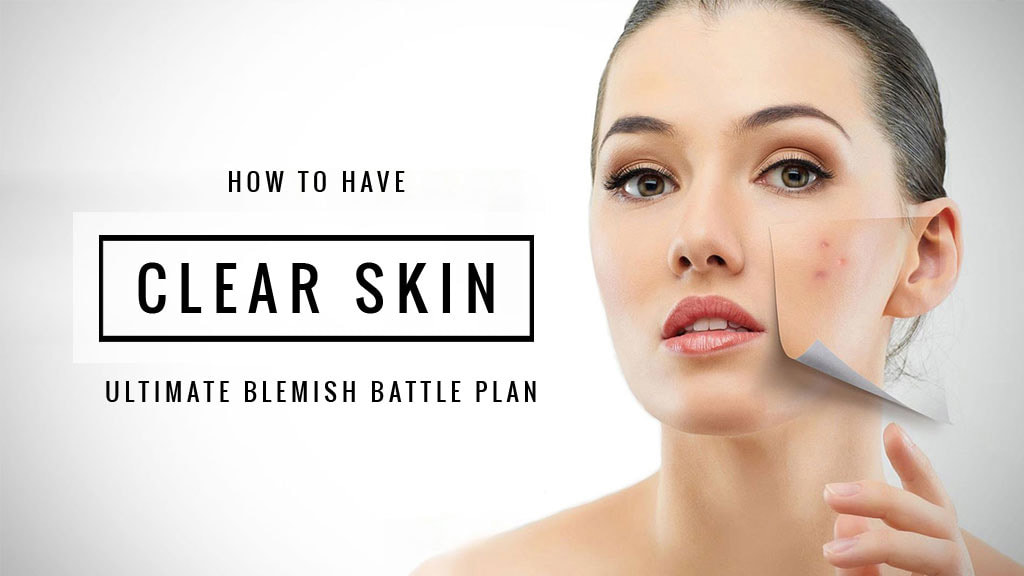|
Pore-Clogging Ingredients
Below is a list of ingredients that can be found in skincare products, makeup, and hair products that can clog your pores and may exacerbate acne. Always check the ingredients of any non-Face Reality products you use on your skin or hair, even if it says “Won’t Clog Pores” or “Non-Comedogenic” on the bottle. Natural oils can be some of the worst o enders (like cocoa butter and coconut oil) and are found in many “organic” skin care lines. Other oils such as jojoba, olive, and lanolin are mildly comedogenic and can be a problem if formulated with other comedogenic ingredients. Some prescription products like the cream form of Retin-A, as well as many over-the-counter acne medications also contain pore clogging ingredients. “Oil-free” products can be formulated with pore-clogging ingredients. Be Aware
Additional Notes: Skin needs can change based on hormone levels, climate, medications, etc.
--------------------------------------------------------------------------------------------------------------------------------- Pore Clogger List A & D Additive Acetvlated Lanolin Ahnfeltia Concinna Extract Alaria esculenta Algae Extract Almond Oil Andiroba Seed Oil Apricot Kernel Oil Ascophyllum (and extracts) Ascorbyl Palmitate (1-2 so usually fine, especially if towards end of label; if towards top, might want to avoid) Astrocaryum Murumuru Seed Butter (this can vary and some may do fine) Avocado Fruit Avocado Butter Avocado Oil Baobab Oil Basic Red Beeswax Bismuth Oxychloride Blue Algae Borage Oil Brazil Nut Oil Brown Algae Buriti Oil Butyl Stearate Butylene Glycol (can be problematic for some if at the top of a label) C13-14 Isoparaffin Camelina Oil Capric Acid Carrageenan Carrot Seed Oil Cera Alba Ceteareth 20 Ceteareth-6 Olivate Cetearyl Alcohol + Ceteareth 20 (when both are in product together) Cetyl Acetate Cetearyl Olivate (most do fine) Cetrimonium Bromide Cetrimonium Chloride Cherry Seed Oil Cheru Seed Oil Chlorella Chondrus Crispus Chullu (Wild Apricot) Seed Oil Cladosiphon Okamuranus Extract Cocoa Butter Coconut Coconut Butter Coconut Alkanes Coconut Oil Cocos Nucifera Codium Fragile Extract Corallina Officinalis Extract Corn Oil Cottonseed Oil Cranberry Seed Oil Cupuacu Butter D & C Red D & C Red 17 D & C Red 19 D & C Red 21 D & C Red 27 D & C Red 3 D & C Red 30 D & C Red 33 D & C Red 36 D & C Red 4 D & C Red 40 D & C Red 6 D & C Red 7 D & C Red 9 Date Seed Oil Decyl Oleate Dhupa Seed Oil Di (2 Ethylhexyl) Succinate Dioctyl Malate Dioctyl Succinate Dunaliella Salina Extract (algae) Eicosanoic Acid Ethoxylated Lanolin Ethelhexyl Cocoate Ethylhexyl Palmitate Ethylhexyl Pelargonate Evening Primrose Oil Flaxseed Oil Fractionated Coconut Oil Fucus Vesiculosus Gigartina Skottsbergii Extract Glyceryl Isostearate Glyceryl Oleate Glyceryl Oleate Citrate Glyceryl Stearate SE Glyceryl-3-Disostearate Glycine Soya Oil (soybean) Grapeseed Butter Grapefruit Seed Oil Green Algae Green Coffee Oil Groundnut Oil Haematococcus pluvialis Extract Haslea Ostrearia Extract Hazelnut Seed Oil Hemp Seed Butter Hexadecl Alcohol Hexyl Laurate Hexylene Glycol (depends on source) Himanthalia Elongate Extract Hydrogenated Vegetable Oil Irish Moss Isoceteth-20 Isocetyl Alcohol Isocetyl Stearate Isodecyl Oleate Isononyl Isononoanoate Isopropyl Isostearate Isopropyl Lanolate Isopropyl Linolate Isopropyl Myristate Isopropyl Neopentanoate Isopropyl Palmitate Isopropyl Titanium Triisostearate Isostearate Isostearic Acid Isostearyl Isostearyl Isostearate Isostearyl Neopentanoate Jojoba Butter Jojoba Oil Jojoba Wax Kappaphycus Alvarezii Extract Karanja Oil Kukui Nut Oil Kapok Oil Kelp Kukui Nut Kukui Oil Laminaria Laminaria Longicruris Extract Laminaria Digitata Extract Laminaria Saccharina Extract Laneth 10 Lanolic Acid Lanolin Lanolin Oil Lanolin Alcohol Laureth 12 Laureth 23 Laureth 4 Laureth 7 Lauric Acid Lauroyl Lysine (coconut derivative that some can be reactive too) Lauryl PEG-8 (fine for most) Lauryl Olivate Linseed Macadamia Nut Oil Magnesium Myristate Mahua Seed Oil Mango Butter Marula Oil Mastocarpus stellatus Microcystis aeruginosa Mink Oil Moringa Oil Myreth-3 Myristate Octodidecyl Stearoyl Stearate Octyl Palmitate Octyl Stearate Octyldodecanol (this should be fine in skincare with such small amount but if severely acne prone may need to avoid) Oleth-10 Oleth-20 Oleth-3 Oleth-3 Phosphate Oleth-5 Oleyl Alcohol Olea Europaea Fruit Oil Olive Oil Olive Butter Olive Oil Olive Oil Peg-7 Esters Ozokerite (1-2 so most are fine) Myristic Acid Myristyl Alcohol Myristyl Lactate Myristyl Myristate Myrtrimonium Bromide Nahor Seed Oil Neem Oil Padina Pavonica Extract Palm Oil Palmitic Acid Palmaria Oalmarta Extract (Dulse) Parrafin Peach kernel oil Palash Oil Palm Kernel Oil Palm Oil Palm Oil Butter Papaya Seed Oil Peach Kernel Oil Peanut Oil Pecan Oil Pequot Oil Pine Nut Oil PEG 16 Lanolin PEG 2 Sulfosuccinate PEG 200 Dilaurate PEG 65 PEG 8 Stearate PEG 100 Distearate PEG 150 Distearate Peg 16 Lanolin PEG 200 Dilaurate Pentaerythrital PG Caprylate/Caprate PG Dipelargonate PG Monostearate Phytantriol Pilu Oil Plankton Plankton Extract (may be find based on formulation) Potassium Cocoate Polyglyceryl-4-Caprate (fine for most) Polyglyceryl-2 Stearate (fine for most) Polyglyceryl-3 Diisostearate Polyglyceryl-4 Isostearate Polyglyceryl-Diisostearate Polyhydroxystearic Acid Polyquanterium-4 Porphyridium Cruentum (or other forms of the Porphyra species) PPG 10 Cetyl Ether PPG 12 PPG 2 Myristyl Propionate PPG Ceteth 10 Phosphate PPG-2 Myristyl Propionate Pracaxi Oil Propylene Glycol Monostearate Prunus Dulcis Oil Pumpkin Seed Oil Rapeseed Oil Ratanjyat Oil Red Algae Red Palm Oil Retinyl palmitate Rice Bran Oil (1-2 so should be fine) Sal Seed Oil Sandalwood Seed Oil Sapote Oil Sargassum Fillpendula Extract Sclerocarya Birrea Seed Oil Sea Grass Sea Whip Extract Seaweed Sesame Oil Shea Butter Shark Liver Oil Shea Butter Shea Nut Oil Sodium Alginate Sodium Carbomer Sodium Chloride (may be an issue in large concentrations like in detergent but some are sensitive to this in skincare and makeup; this is key ingredient in Tower 28 and E11element spray) Sodium Laurel Sulfate Soil Minerals Sorbitan Isostearate (1-2 so most do fine with this) Sorbitan Laurate Sodium Laureth Sulfate (SLS) Sorbitan Oleate Sorbitan Olivate (most do fine with this) Soy Soy Protein Soybean (extracts should be fine) Soy Oil Soybean Oil Soja Sova Spirulina Stealkonium Chloride Steareth 10 Steareth 2 Steareth 20 Stearic Acid (scores a 2, but should be fine if not at the top of the label) Stearic Acid TEA Stearyl Alcohol (can be a problem for some if barrier is compromised) Stearyl Heptanoate Sulfated Jojoba Oil Sunflower Butter Sweet Almond Butter Sweet Almond Oil Talc Tallow Tamanu Oil Tetraisostearate Tocopherol (under 2% ok) Tucuma Butter Tribehenin Triethanolamine Ulva lactuca (sea lettuce) Undaria Pinnatifida Vitamin A palmitate Vitamin E Oil (under 2% ok) Water Soluble Sulfur Wheat Wheat Germ Oil Wheat Germ Glyceride Xylene
1 Comment
Non-Inflammatory Acne
Acne is typically categorized into two main types: non-inflammatory and inflammatory acne. Although there are two primary categories, there are many different types of acne which we'll discover later on. Non-inflammatory acne is characterized by comedones, which can be open or closed. These comedones are more commonly known as whiteheads and blackhead and are generally referred to as different types of pimples. Blackheads If the pore stays open on the surface of your skin, it’s considered an open comedo, also known as a blackhead. Because the pore is open, the sebum inside the pore oxidizes upon contact with the air; this hardens the sebum, and once the air mixes with melanin skin pigment, the blackhead forms a dark coloration that can appear black, brown, or gray. Blackheads can usually be found on the nose, chin, and forehead, but might also be found on the chest, back, and arms. Blackheads tend to be rampant at the onset of puberty and during times of hormonal change. Whiteheads If a pore is not open and covered by a thin layer of skin, sebum and dead skin cells accumulate, resulting in a thick substance that remains stuck under the skin, forming a plug. While these are not usually infected, bacteria can affect the skin cells surrounding the pore. Whiteheads don’t usually last as long as blackheads, with an average cycle of a week. Whiteheads tend to be found on the face, but may also be observed on other parts of the body. Inflammatory Acne Inflammatory breakouts are a result of P. Acnes bacteria infecting the pore and causing an infection, and can often be more difficult to treat. There are four types of inflammatory acne, sometimes commonly referred to as different pimple types: papules, pustules, nodules, and cysts. Papules Papules are small, raised, solid pimples that don’t contain pus and are usually the first type of inflammatory acne to affect the skin. Papules don’t display a visible pore and tend to be red in color and surrounded by swollen and inflamed tissue. They may be tender to the touch. Pustules Pustules are pimples that are noticeably white or yellow in the middle and are filled with pus. The marked difference between papules and pustules is that pustules contain white blood cells. When your immune system attempts to fight bacteria that’s made its way into a ruptured follicle, it will set off a buildup of white blood cells, resulting in pus production. The skin around pustules tends to be tender and inflamed. Nodules Acne nodules appear during the latter stages of a breakout and are usually seen in severe cases of acne. They present as large, tender bumps underneath the skin’s surface and can feel hard and stiff to the touch. Similarly to papules, nodules form from a buildup of bacteria, skin cells, and sebum in the follicles, but this formation is rooted deeper in the skin. This deep buildup can cause tissue damage to the skin and prompt the immune system to begin an inflammatory response. While they look similar to papules, nodules are much bigger and more painful. They do not contain any pus, but can remain buried within the skin for a long time. They may be dormant and rear up in occasional bouts. If squeezed or ruptured, these nodules can spread over a larger area of the skin and cause deep infections. These lesions can cause damaging and permanent scars to the skin. Cysts Cystic acne is one of the hardest types of acne to successfully treat. Unlike pimples, acne cysts form deep below your skin tissue and do not come to a head. Cysts are similar to nodules, except for the presence of pus. Cysts are almost always painful to the touch and can cause great discomfort, and they don’t necessarily look like a pimple. They may just appear as a large, swollen, and red lump on the skin. They may occur independently, or you may find your skin has large clumps of cysts grouped together. Cystic acne is less prevalent; where general acne affects 70 out of 1,000 people, cystic acne affects 2 in every 1,000 people according to Medical News Today. This severe form of Acne Vulgaris usually requires the help of a dermatologist in conjunction with self-care and preventative measures. Inflammatory acne takes much longer to heal and can have permanent effects on the skin, so it’s important to determine the best treatment methods for your skin condition. Sebaceous Filaments If you’ve noticed a plethora of small grayish dots appearing across your face, especially on your nose or chin, you might incorrectly label them as blackheads. Those are actually not blackheads, they are what’s known as sebaceous filaments. These are naturally occurring hair-like formations that follow the flow of oil along the inside of a pore. If you have oily skin or larger pores, they’re more noticeable. These become visible as a pore is filled with sebum. While blackheads also begin as pores filled with sebum, it’s only once a pore is plugged with dead skin cells that it becomes an actual comedo. It’s easy to see the difference between blackheads and sebaceous filaments when it comes to extraction. When extracted, a blackhead has a dark, hardened, plug-like appearance. Sebaceous filaments are expelled in a flowing stream of sebum that takes on a waxy consistency. You can also observe a difference in the colors of these lesions; a blackhead will be quite dark on the surface of your skin, where sebaceous filaments may be yellow-tinged, gray, or take on the hue of surrounding skin. Even when these filaments are extracted, they generally refill with sebum within 30 days. There’s no way to completely rid the skin of these sebaceous filaments, but keeping your face clean with a regimen of regularly treating acne can help minimize their appearance and keep those pores cleaned out. Severity Grades When it comes to acne diagnoses, Acne Vulgaris is measured on grades of severity, and can be diagnosed in four different classifications. Grade I Patients diagnosed with Grade I acne generally exhibit mild forms of this skin condition. Their skin may have whiteheads, blackheads, and small pimples. There’s not usually inflammation present with this type of acne breakout, and mild cases like these can often be self-diagnosed. Usually, this type of breakout occurs on the nose and forehead and most often appears in adolescence. Adults may also experience this type of acne, usually with blackheads on the nose or forehead. Grade II Moderate acne falls under a Grade II severity qualification. Those with this grade of acne will likely exhibit a plethora of comedones on the skin. There will be more frequent breakouts, likely accompanied by pustules and papules that may be more sensitive to the touch. Grade III This grade of acne is accompanied by a large amount of inflammation in comparison to the lesser grades. The skin will exhibit numerous papules and pustules, and there may be nodules present. Grade IV This is the most severe form of acne, and will see skin filled with nodules, cysts, pustules, and papules. With this severity grade, acne tends to be spread across more than just the face; the back, chest, neck, and buttocks may also experience frequent breakouts. Acne of this severity can cause significant scarring and may disfigure the skin if left untreated. According to the American Academy of Dermatology, oral isotretinoin is the only medication approved to treat severe cystic acne. For most people, acne is an inherited condition of the pores. When someone is prone to acne, their pores clog with dead skin cells much faster than normal. Healthy pores shed about one layer of dead skin cells per day inside the pore, but acne-prone pores shed up to five layers of dead skin cells per day. The body just can’t keep up with keeping the pore clear. Technically, this is called “retention hyperkeratosis” — dead skin cells shedding more quickly than the pore can expel them. This first picture is of a normal healthy pore. As the dead skin cells begin to accumulate inside the pore, the cells become sticky and get stuck inside the pore and form a plug. Medically, this is called a “microcomedone” – essentially the precursor to all acne. As you can see in this picture, there are more dead skin cells shedding inside the pore. Hormonal fluctuations trigger more oil production inside the pore. Normally, this isn’t a problem because the dead skin cells don’t get trapped. But with acne prone-skin, when the dead skin cells shed more quickly and form a blockage, the perfect environment for the P. Acnes bacteria is created. The oil is a nutrient for the bacteria, so the bacteria proliferates. So you see, bacteria is not the “cause” of acne, it is the effect of too many dead skin cells. This is an important distinction to remember. But, some people don’t get inflamed lesions — inflammation is also an inherited tendency. If the dead skin cells and the oil that form the plug don’t become inflamed, the plug becomes a whitehead; that is, a non-inflamed lesion under the skin, also called a “closed comedone”. Or the plug can become a blackhead, which is a non-inflamed acne lesion where the pore remains open, also known as an “open comedone”. In the case of a blackhead, the tip of the plug darkens as it is exposed to oxygen in the environment. As the oil in the pore builds up, inflammation can develop in the cells surrounding the pore. Blackheads can be infected or not depending on whether the P. acnes bacteria have affected the cells around the pore. As the oil and the dead skin cells build up, they put pressure on the cells surrounding the pore. With enough pressure, the sides of the pore rupture and the contents of the pore leak into the surrounding skin. Because this sebaceous material contains a lot of P. acnes bacteria, the surrounding skin now becomes infected, creating a red bump that we know as a pimple. The medical term for this red bump is an inflammatory papule. This next drawing shows an inflammatory pustule, which is different from a pimple only in that it contains white blood cells. When the immune system fights off the P. acnes infection, white blood cells, which are soldiers of the immune system — pile up, creating pus in the pore. Now another, deeper inflamed lesion can form called a nodule or cyst. It is a solid dome-shaped lesion that extends below the surface, deep into the layers of the skin. Scarring is common with nodules and can sometimes leave an impaction behind, which can flare again and again. When a group of pustules cluster together under the skin, they form a cyst. An acne cyst can appear similar to a nodule, but is pus-filled, and can have a diameter of 5mm or more across. They are usually very painful and scarring is common with cysts. Conclusion:So you see, acne is primarily an inherited dead skin cell problem. Most acne, no matter what form it takes, starts with microcomedones. This means the solution lies in products that penetrate the pore and prevent dead skin cells from building up. That’s why your home care routine is so crucial — it’s all about preventing the microcomedones (the beginning of acne) from forming at all. This is the best way to get rid of acne. |
ARCHIVES
Categories |
|
Client Intake Form
Facial In-Take Form |
650 HUNGERFORD DRIVE
SUITE, 200 ROCKVILLE MD 20850 301-309-9088
|
Copyright © 2024 Annie Beauty Spa - All Rights Reserved.




